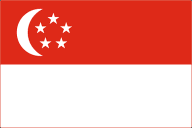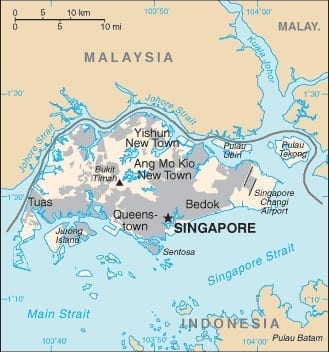
| Location and Size | Credit and Collections |
| Government | Risk Assessment |
| Legal System | Business Climate |
| People | Business Protocol |
| Economy | |
| Comparative Indicators |
12345
Location and Size
Singapore is a city-state with an area of 704 sq. km. (271 sq. mi.).
The country comprises the main island – linked by a causeway and a bridge to the southern tip of Malaysia – and some 50 smaller islands.
Government
Singapore is a parliamentary republic, became internally self-governing in 1959, and gained formal independence from Britain on August 9, 1965.
Branches of the government include:
- Executive: President (chief of state) Halimah Yacob; Prime Minister (head of government) Lee Hsien Loong.
- Legislative: Unicameral 84-member Parliament (maximum 5-yr. term).
- Judicial: High Court, Court of Appeal, subordinate courts.
Legal System
Singapore’s legal system is based on English common law. Singapore has not accepted compulsory International Court of Justice (ICJ) jurisdiction.
People
- Population: 5,975,383 (2023)
- Population growth rate: 0.9% (2023)
- Languages: English (official) 48.3%, Mandarin (official) 29.9%, other Chinese dialects (includes Hokkien, Cantonese, Teochew, Hakka) 8.7%, Malay (official) 9.2%, Tamil (official) 2.5%, other 1.4%;
- Literacy: 97.5% (2023)
- Ethnic Make-up: Chinese 74.2%, Malay 13.7%, Indian 8.9%, other 3.2% (2021 est.)
- Religions: Buddhist 31.1%, Christian 18.9%, Muslim 15.6%, Taoist 8.8%, Hindu 5%, other 0.6%, none 20%
Economy
Singapore has a highly developed and successful free-market economy. It enjoys an open and corruption-free environment, stable prices, and a per capita GDP higher than that of most developed countries. Unemployment is low. The economy depends heavily on exports, particularly of consumer electronics, information technology products, medical and optical devices, pharmaceuticals, and on its vibrant transportation, business, and financial services sectors.
The government is attempting to restructure Singapore’s economy by weaning its dependence on foreign labor, addressing weak productivity, and increasing Singaporean wages. Singapore has attracted major investments in pharmaceuticals and medical technology production and will continue efforts to strengthen its position as Southeast Asia’s leading financial and high-tech hub. Singapore is a member of the 12-nation Trans-Pacific Partnership free trade negotiations, as well as the Regional Comprehensive Economic Partnership negotiations with the nine other ASEAN members plus Australia, China, India, Japan, South Korea, and New Zealand. In 2015, Singapore formed, with the other ASEAN members, the ASEAN Economic Community.
- Currency: Singapore Dollar (SGD)
- Leading Markets (2023): China 14.7%, Hong Kong 12.6%, Malaysia 10.8%, US 6.6%, Indonesia 5.8%, Japan 4.7%, South Korea 4.6% Thailand 4%
- Leading Exports – Commodities: Machinery and equipment (including electronics), consumer goods, chemicals, mineral fuels
- Leading Suppliers (2023): China 13.9%, Malaysia 12%, US 10.7%, Japan 6.3%, South Korea 5%
- Leading Imports – Commodities: Machinery and equipment, mineral fuels, chemicals, foodstuffs
- Top Industries: Electronics, chemicals, financial services, oil drilling equipment, petroleum refining, rubber processing and rubber products, processed food and beverages, ship repair, offshore platform construction, life sciences, entrepot trade
- Top Agricultural Products: Rubber, copra, fruit, orchids, vegetables, poultry, eggs, fish, ornamental fish
Comparative Economic Indicators – 2023
| Singapore | Indonesia | Malaysia | Philippines | India | Thailand | |
| Population (millions)* | 5.975 | 262.78 | 31.8 | 105.8 | 1.339 | 68.9 |
| Population growth rate (%)* | 0.9% | 0.83% | 1.5% | 1.55% | 1.04% | 0.25% |
|
Age Structure (%)
(15 to 64 years old) |
73.04% | 68.11% | 66.17% | 62.32% | 74.40% | 68.55% |
|
Age Structure (%)
(65+ years old) |
11.84% | 7.26% | 6.35% | 4.61% | 7.9% | 5.82% |
| Literacy (%) | 97% | 95.4% | 94.6% | 96.3% | 3.7% | 82.6% |
| Unemployment rate (%) | 2.7% | 5.4% | 3.4% | 5.7% | 9.7% | 6.40% |
| Inflation (%) | 4.8% | 3.8% | 3.8% | 2.9% | 2.83% | 5.30% |
| Population below poverty line (%) | 11.9% | 10.9% | 10.7% | 21.6% | 4.86% | 24.90% |
| GDP** (USD billion) | $397 | $3,250.0 | $933.26 | $877.2 | $611.8 | $34.98 |
| GDP real growth rate (%) | 7.6% | 5.1% | 5.9% | 6.7% | 7.2% | 4.90% |
| GDP per capita** (USD) | 72,794 | 12,700 | 29,100 | 8,400 | 5,100 | 5,300 |
| Public debt (% of GDP) | 72.9% | 28.90% | 54.1% | 39.2% | 39.50% | 33.30% |
| Industrial production growth rate (%) | 1.1% | 4.1% | 5.0% | 7.2% | 7.26% | 5.34% |
| Exports (USD billions) | $579 | $168.9 | $187.9 | $48.20 | $52.50 | $51.94 |
| Imports (USD billions) | $34.3 | $150.1 | $160.7 | $89.39 | $49.70 | $42.75 |
| Reserves of foreign exchange and gold (USD billions) | 343.7 | 130.2 | 102.4 | 81.57 | 96.6 | 49.5 |
| Currency | Dollar (SGD) |
Rupiah (IDR) |
Ringgit (MYR) |
Piso (PHP) |
Rupee (PKR) |
Bhat (THB) |
| Exchange rates (per USD) 2/23/2024 | 0.74 | 0.000064 | 0.21 | 0.18 | 0.12 | 0.28 |
| Exchange rates (per EUR) 2/23/2024 | 0.69 | 0.000059 | 0.19 | 0.16 | 0.11 | 0.26 |
*Economic Data from CIA World Factbook
** PPP Purchasing Power Parity
Credit and Collections
Debt collection companies, including their key appointment holders, must also be assessed by Police to be fit and proper before they are allowed to offer debt collection services. As of March 1, 2024, all debt collection companies must be licensed to carry out debt collection activities.
Risk Assessment
Coface Country Risk Rating: A2 — The political and economic situation is very good. A quality business environment has a positive influence on corporate payment behavior. Corporate default probability is very low on average.
Coface Business Risk Rating: A1 — Major regional and international trading hub for goods and financial services.
Business Climate
Upon independence in 1965, Singapore was faced with a lack of physical resources and a small domestic market. In response, the Singapore Government adopted a pro-business, pro-foreign investment, export-oriented economic policy framework, combined with state-directed investments in strategic government-owned corporations.
Singapore’s strategic location on major sea lanes, coupled with its pro export oriented policy framework, has allowed its small economy to be one of the most competitive and flexible in the world. The Singaporean economy has shown a high degree of resilience, recording solid economic growth rates. Owing to an efficient, well maintained business environment, Singapore has long benefited from vibrant entrepreneurial activity.
The country’s largely corruption-free government, skilled work force, and advanced, efficient infrastructure have attracted investments from more than 7,000 multinational corporations from the United States, Japan, and Europe.
The government hopes to establish a new growth path that will be less vulnerable to the global demand cycle for information technology products, and less vulnerable to a world economic downturn. It has succeeded in attracting major investments in pharmaceuticals and medical technology production while continuing efforts to establish Singapore as Southeast Asia’s financial and high-tech hub.
Foreign firms are found in almost all sectors of the economy. Multinational corporations account for more than two-thirds of manufacturing output and direct export sales, although certain services sectors remain dominated by government-linked companies.
Private Ownership: Foreign and local entities may readily establish, operate, and dispose of their own enterprises in Singapore. Except for representative offices (where foreign firms maintain a local representative but do not conduct commercial transactions in Singapore), there are no restrictions on carrying out remunerative activities.
Transparency of Regulatory System: Regulations are straightforward. Virtually all commercial operations are performed with transparency and speed.
Intellectual Property Rights: Singapore has developed one of the strongest intellectual property (IP) regimes in Asia. Singapore is a member of the WTO and a party to the Agreement on Trade-Related Aspects of Intellectual Property Rights (TRIPS). It is a signatory to other international copyright agreements, including the Paris Convention, the Berne Convention, the Patent Cooperation Treaty, the Madrid Protocol, and the Budapest Treaty.
Singapore’s piracy rate averages about 5-10% for audio and video and 39% for business software. Software piracy levels in Singapore, while among the lowest in Asia, are almost double the estimated level in the United States. Rights holders have encountered difficulties when attempting to prosecute IP cases based on tips provided by company insiders. Singapore currently does not offer specific protection to “whistleblowers”. As a result, many informants refuse to provide crucial testimony in court.
U.S. industry has raised concerns that Internet piracy in Singapore is on the rise due to the increasing availability of the country’s broadband facilities.
Conversion and Transfer Policies: Singapore places no restrictions on reinvestment or repatriation of earnings and capital, and maintains no significant restrictions on remittances, foreign exchange transactions and capital movements.
Corruption: Corruption is almost nonexistent. Singapore has, and actively enforces, strong anti-corruption laws. When cases of corruption are uncovered, whether in the public or private sector, the government deals with them firmly, swiftly and publicly. Singapore is not a party to the OECD Convention on Combating Bribery, but the Prevention of Corruption Act makes it a crime for a Singapore citizen to bribe a foreign official or any other person, whether within or outside Singapore.
Economic Freedom: Singapore’s economic freedom score is 83.5, making its economy the number one freest in the 2024 Index of Economic Freedom. Singapore is ranked 1st out of 39 countries in the Asia-Pacific region, and its overall score is significantly higher than the world average.
Business Protocol
Singapore is a multi-ethnic society where Chinese, Malay, and Indian traditions coexist beneath the veneer of a western cosmopolitan metropolis.
Singaporeans are very sensitive to retaining face in all aspects of their lives. Face indicates personal dignity and is a prized commodity that can be given, lost, taken away or earned. It is a mark of personal qualities such as a good name, good character, and being held in esteem by one’s peers. It can also be greater than the person and extend to family, school, company, and even the nation itself.
Singaporeans claim they are an egalitarian society, yet they retain strong hierarchical relationships that can be observed between parents and children, teachers and students, and employers and employees. This reliance on hierarchy is drawn from Confucianism, which emphasizes respecting age and status, and even blind obedience to one’s elders. In the workplace, this is seen in the increased deference that is paid to employees who are older.
Business in Singapore is more formal than in many western countries. There are strict rules of protocol that must be observed. The group (company or department) is viewed as more important than the individual. People observe a strict chain of command, which comes with expectations on both sides. In order to keep others from losing face, much communication will be non-verbal and you must closely watch the facial expressions and body language of people you work with.
**********
Subscribe to the Credit-to-Cash Advisor
Monthly e-Newsletter — It’s Free
This information is provided by ABC-Amega Inc. Providing international receivable management and debt collection services for exporters to more than 200 countries. For further information, contact [email protected].
